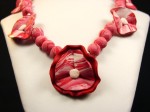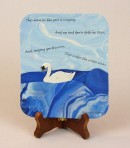Millefiori
by Jennifer Araya
I was first introduced to polymer clay when I was about 12 years old and received a polymer clay starter kit as a Christmas gift. The book that came with the kit (which I still use even now) has a huge section on various millefiori techniques, and it fascinated me from the very start. The idea that such intricate, delicate designs could be crafted out of colored clay – not painted on but rather inherent in the clay itself – amazed me, and I knew I had to figure it out for myself.
Here’s a lowdown of the basic process:
- I start with long strips of clay and delicately form them around one another to form a cane, like those in the photo below. When a cane is first assembled, it could be anywhere from 1/2 inch to 2 inches in diameter – big enough that it’s easy to get the clay in exactly the arrangement I need.
- I then slowly roll the cane out, rolling it smaller and smaller until it reaches the diameter I want. Sometimes, I keep the canes fairly thick. The cane used for the apple leaf on the Personalized Teacher’s Ornament, for example, is over 1/2 inch thick. Other canes, like those on the beads in the Blue & White Millefiori Necklace, are much less than 1/4 inch in diameter.
- After rolling the cane to the appropriate size, I wrap it in plastic wrap and leave it in the freezer for about 30 minutes. Polymer clay gets very hot and pliable as one works with it, and the process of rolling out a cane makes the clay quite warm – warm enough that if I tried to slice it as-is, the design would smear down the cut in the cane, completely ruining the design. Putting the cane in the freezer for a few minutes allows the design to set and helps me cleanly slice the cane.
- The last step is to slice the cane into discs, revealing the intricate designs contained within the heart of the cane. I then layer the discs on the piece I want to decorate, and viola! A beautifully decorated clay creation.
What JennJill Designs item would you like to know more about? Let Jennifer know, and she’ll be sure to describe the design and creation process in a future newsletter.




